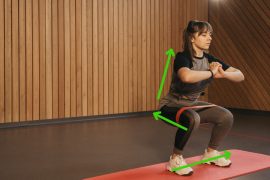The bench press is one of the most popular exercise to build up strength and muscle in your chest, shoulders, and arms. But if you don’t use proper form, the bench press can also be pretty dangerous. That’s why it’s so important to learn how to do it right.
Now, the bench press might seem pretty straightforward – you just lie back on a bench and push a barbell up, right? Well, there’s a bit more to it than that. Things like your hand placement, foot positioning, and back arch can all make a big difference in how the lift feels and how effective it is.
You will also need to avoid some of the most common mistakes people make and how to bench press with proper form. That way, you can be sure you’re doing the bench press safely and getting the most out of the exercise.
How to do Bench Press with Proper Form?
To perform the bench press with proper form, follow these steps:
Step-1: Set Your Feet: To do the bench press correctly, start by keeping your feet back towards your butt as far as you can while still keeping them flat on the floor. Plant your feet firmly so you can generate power from the ground through your whole body.
Step 2: Position yourself under the Bar: position yourself under the barbell so it’s easy to take it off the rack, but not so far that you hit the pegs on the way up. To keep your shoulders safe and stable, squeeze your shoulder blades together. Also, push your upper back into the bench.
Step 3: Arch Your Back: Maintain a slight arch in your lower back to keep your spine neutral and your back tight and safe. Powerlifters may arch their back more to reduce the distance the bar has to move.
Step 4: Set Your Grip: Grip the bar tightly, holding it as far down your palm as possible. Avoid gripping too high or using a false grip. The width of your grip will depend on your body type and goals.
Step-5: Brace and Unrack: Take a deep breath, unrack the bar, and let the breath out. Push your back into the bench to lift the bar off the rack without wasting energy.
Step 6: Breathe In and Lower the Bar: Before lowering the bar, take another deep breath and hold it to brace your core. Bend the bar into a U-shape with your hands to engage your lats and protect your shoulders. Hold your breath until you pass the hardest part, then breathe out forcefully as you push the bar back up.
Step-7: Touch Your Chest: The bar should touch your body where your forearms are at a 90-degree angle to the ground. This exact spot will depend on your arm length and grip width.
Step-8: Push With Leg Drive: Once the bar touches your chest, tighten your glutes and drive your legs into the ground to start the upward movement. Use this leg drive to stay tight and lift more weight. Breathe out powerfully through the hardest part of the lift.
Having the right form is important when you bench press. If you don’t do it right, you could get hurt. If you don’t, you won’t be able to lift as much weight.
You want to avoid a few things. Don’t let the barbell bounce off your chest. Make sure to breathe and brace your core properly. Keep your elbows from flaring out. Don’t let your shoulders roll forward. And don’t move your feet around.
If you do all those things right, you’ll be able to lift more weight safely. It takes some practice, but it’s worth it to prevent injuries and get stronger.
How To Add The Bench Press Into Your Workout Routine?
Adding the bench press into your workout routine can be a great way to build upper body strength and muscle. Here are some recommendations for beginners, intermediate lifters, and pro bodybuilders:
Bench Press Workout Plan
For Beginners: Aim to include the bench press exercise in your routine 1-2 times per week. Begin with 3-4 sets of 8-12 repetitions. This rep range will help you develop strength and muscle endurance while allowing you to practice the movement with lighter weights.
For Intermediate Lifters: Increase the frequency of bench press sessions to 2-3 times per week. Perform 4-5 sets of 6-8 repetitions. This rep range will help you build strength and muscle size. Consider using heavier weights while maintaining proper form.
For Pro Bodybuilders: Incorporate a variety of bench press variations, including different angles, grips, and equipment (such as resistance bands or chains). Sets and Reps: Perform 4-6 sets of 4-6 repetitions with heavy weights. This rep range will help you build maximum strength and muscle density.
Remember, these are general guidelines. The best number of sets for you may be different based on your fitness level, goals, and how your body responds. It’s a good idea to start on the lower end and slowly increase the volume as your body gets used to the exercise.
Types of Bench Press to Gain Strength and Muscles
Traditional flat barbell bench press is the most common variation, several other types of bench press exercises can be used to target different muscle groups and achieve different training goals. Here are some of the most common types of bench press exercises:
1. Close Grip Bench Press
The close grip bench press is a variation of the standard bench press where the hands are placed closer together on the barbell, usually with the index fingers just outside of the smooth part of the bar. This type of Bench Press places more emphasis on the triceps muscles, as they have to work harder to extend the arms and lift the weight.
2. Incline Bench Press
The incline bench press is performed with the bench set to an incline angle, usually between 30-45 degrees. This variation targets the upper chest muscles more than the traditional flat bench press, as the incline position shifts the focus of the movement to the upper pectoralis major and anterior deltoid muscles.
3. Decline Bench Press
The decline bench press is the opposite of the incline bench press, with the bench set to a decline angle, usually between 15-30 degrees. This type of Bench Press places more emphasis on the lower chest muscles and can help to develop a fuller, rounder chest appearance.
4. Dumbbell Bench Press
The dumbbell bench press is performed with a pair of dumbbells instead of a barbell. This variation allows for a greater range of motion and can help to address muscular imbalances between the left and right sides of the body.
5. Banded Bench Press
The banded bench press involves attaching resistance bands to the ends of the barbell or to the bench itself. The bands add additional resistance at the top of the lift, which can help to build power and explosive strength.
6. Floor Press
The floor press is performed with the lifter’s back, hips, and legs on the floor, with the barbell lowered until the elbows touch the floor. This type of Bench Press eliminates the stretch reflex from the bottom of the movement and can help to target the triceps muscles.
7. Reverse Grip Bench Press
The reverse grip bench press involves gripping the barbell with the palms facing inward instead of the traditional outward-facing grip. This variation places more emphasis on the biceps and can help to develop a thicker, more developed upper body.
8. Tempo Bench Press
The tempo bench press involves controlling the speed of the movement, with a specific cadence for the eccentric (lowering) and concentric (lifting) phases. This type of Bench Press can help to build muscle endurance and improve technique.
9. Close Grip
The close grip bench press is a variation of the standard bench press where the hands are placed closer together on the barbell, usually with the index fingers just outside of the smooth part of the bar. This variation places more emphasis on the triceps muscles, as they have to work harder to extend the arms and lift the weight.
10. Standard Grip
The standard grip bench press is the traditional and most common variation of the bench press, where the hands are placed approximately shoulder-width apart on the barbell.
11. Swiss Bar
The Swiss bar, also known as the football bar or multi-grip bar, is a barbell with multiple grip positions that can be used for the bench press. This type of Bench Press allows for a more natural and comfortable hand position, which can be beneficial for individuals with wrist or elbow pain.
12. Standard Grip Flat Barbell Bench Press
The standard grip flat barbell bench press is the classic and most widely recognized form of bench press exercise. This type of Bench Press involves using a standard, shoulder-width grip on a flat bench to target the chest, shoulders, and triceps muscles.
Benefits of Bench Press for Strength training
Here are the key benefits of the bench press exercise:
The bench press is a key exercise in many strength training programs. This is an effective way to gain strength and size by targeting key muscles in the upper body. With consistent use and proper practice, the bench press can provide significant gains in upper body pressing strength.
How much should a 70 kg man bench press?
The amount a person can bench press varies depending on factors such as training experience, genetics, and body composition. As a general guideline, a 70 kg man who is relatively new to lifting weights may be able to bench press around 50-70 kg.
However, with consistent training and proper technique, it is possible to increase this weight over time.
What is a good bench press routine?
A good bench press routine should focus on progressive overload, proper form, and balanced muscle development.
Here is a simple routine that can help improve your bench press:
Warm-up: Start with 5-10 minutes of light cardio to increase blood flow and warm up your muscles.
Compound exercises: Start with compound exercises that target multiple muscle groups, such as push-ups, dumbbell bench presses, or incline bench presses. Try doing 3-4 sets of 8-12 reps for strength and muscle growth.
Bench press: Perform the bench press exercise with proper form, gradually increasing the weight as you progress. Start with a weight that you can comfortably lift for 8-10 reps and gradually increase the weight over time. Aim for 3-4 sets of 6-8 reps.
Assistance exercises: Include exercises that target the muscles involved in the bench press, such as triceps dips, shoulder presses, and chest flies. You can also do 2-3 sets of 10-12 reps for better results.
Rest and recovery: Allow your muscles to recover between workouts by taking rest days and getting enough sleep.
It’s a good idea to talk to a fitness expert or trainer first, to make sure you do the bench press the right way.
What is the hardest type of bench press?
The hardest type of bench press can vary depending on an individual’s strengths and weaknesses. However, the close-grip bench press is often considered one of the more challenging variations.
This exercise involves placing your hands closer together on the barbell, which increases the emphasis on the triceps. It requires a strong triceps and shoulder strength to perform effectively.
What is the best bench press?
The best bench press is subjective and can vary depending on individual goals and preferences. However, the traditional barbell bench press is widely regarded as one of the most effective exercises for building upper body strength and muscle mass.
It targets the chest, shoulders, and triceps, and allows for heavy loads to be lifted. Other variations, such as dumbbell bench press and incline bench press, can also be effective depending on specific goals and training preferences.













